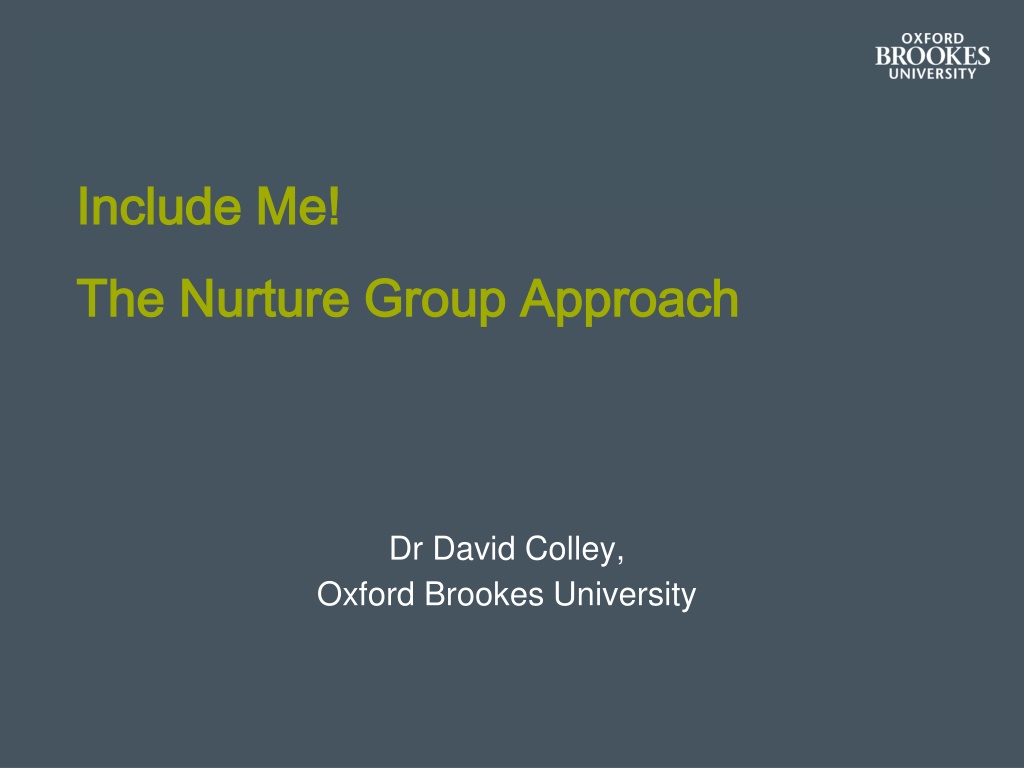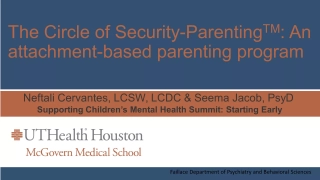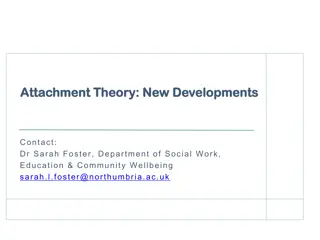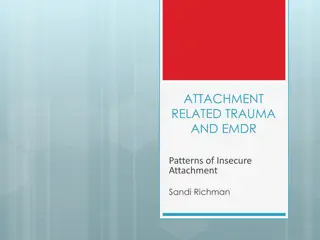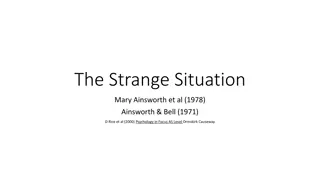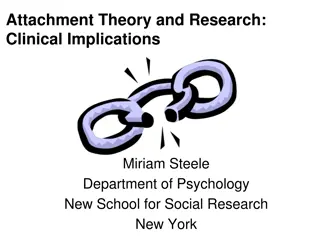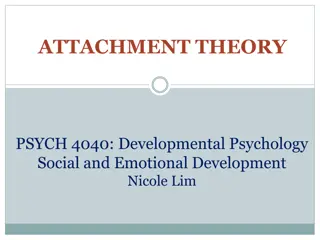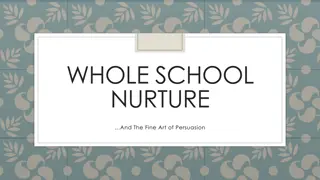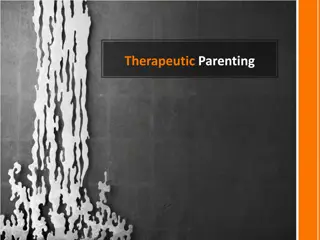Exploring the Nurture Group Approach and Attachment Theory
Delve into the Nurture Group Approach and Attachment Theory, examining the key ideas and theorists involved. Secure attachment and its evolutionary significance in fostering healthy relationships are highlighted. The importance of warm, continuous caregiver relationships in child development is emphasized, alongside discussions on research evidence, criticisms, and assessment tools. Discover how quality attachment predicts future relationships and the role of Nurture Groups in supporting these foundational connections.
Download Presentation

Please find below an Image/Link to download the presentation.
The content on the website is provided AS IS for your information and personal use only. It may not be sold, licensed, or shared on other websites without obtaining consent from the author. Download presentation by click this link. If you encounter any issues during the download, it is possible that the publisher has removed the file from their server.
E N D
Presentation Transcript
Include Me! Include Me! The The Nurture Group Approach Nurture Group Approach Dr David Colley, Oxford Brookes University
Objectives Objectives www.nurturegroups.org What do we already know? Introduction to Attachment Theory Nurture groups: theory and practice Criticisms Research evidence Assessment through the Boxall Profile Resources
What do we know already? What do we know already?
Key Players Key Players Attachment Theory and its critics ..
Attachment Theory: Attachment Theory: the key ideas the key ideas The self emerges from the earliest childhood relationships The root of human personality lies in earliest childhood relationships Children require a warm, intimate, continuous relationship with a primary care giver, bringing satisfaction and enjoyment. Such experiences promote healthy brain development Quality of attachment predicts future relationships
Key theorists Key theorists Bowlby, J. 1969. Attachment and Loss Volume I Attachment. London: The Hogarth Press. Bowlby, J. 1973. Attachment and Loss Volume II Separation Anxiety and Anger. London: The Hogarth Press. Bowlby, J. 1980. Attachment and Loss Volume III Sadness and Depression. London: The Hogarth Press. Ainsworth, M. D. S. 1989. Attachments beyond infancy. American Psychologist, 44, pp709-716. Ainsworth, M. D. S., Blehar, M. C., Waters, E. and Wall, S. 1978. Patterns of attachment: A psychological study of the Strange Situation. Hillsdale, NJ: Erlbaum. Holmes, J. 1993. John Bowlby and Attachment Theory. London: Routledge. Main M. and Solomon J. 1990. Procedures for identifying infants as disorganized/ disoriented during the Ainsworth Strange Situation. In Greenberg M.T., Cicchetti D. & Cummings E.M. (Editors), Attachment in the preschool years (pp121-160). Chicago: Chicago University Press.
Secure attachment Secure attachment Evolutionary component instinct to survive and stay close The safe base contains or helps manage that fear and anxiety Safe base develops through prompt, consistent and appropriate response to needs Access, availability and joy Safe base allows safe exploration (learning) Bowlby s Internal Working Model Nurture Groups accept all these theoretical assumptions
Task 1 Task 1 In pairs or groups, complete the Successful cycle task (a)
Successful cycle Successful cycle 1. Safe base 6. Agency, knowledge, 2. Exploration 3. Uncertainty, not knowing, frustration 5. Success 4. Reassured
Fearful cycle Fearful cycle A base Survival responses exploration Uncertainty, not knowing, frustration Anxiety increases No reassurance
Classic nurture group model: Classic nurture group model: NGs acknowledge the successful and fearful cycles Focus on relationships as the foundation of learning Social and emotional growth as the priority 2 staff Professional training (www.nurturegroups.org) Mainstream school but now also found in alternative provisions Short term, part time and time limited Assessment through the Boxall Profile or the Boxall Profile for Young People Following the 6 principles of nurture group practice
The Six Principles of Nurture The Six Principles of Nurture Groups: Groups: 1. Children s learning is understood developmentally 2. The classroom offers a safe base 3. The importance of nurture for the development of self-esteem 4. Language is a vital means of communication 5. All behaviour is communication 6. The importance of transition in children s lives Task 2
A Typical Nurture Group A Typical Nurture Group Classroom Classroom
The Room The Room
Sofa Area Sofa Area
Kitchen Kitchen
Table Table
Role Play Area Role Play Area
Quiet Area Quiet Area
Criticism of NGs Criticism of NGs Cooper and Whitebread (2007): Various models identified classic NG but also new variant NGs/ groups informed by NG principles/ Aberrant NGs Bailey (2007): children in deficit; requires vulnerability ; implies parental deficits; are NG staff suitably trained? Craig (2010): the focus on self and feelings encourages narcissism and self obsession; weak empirical evidence; a psychological experiment that could backfire. Are NGs value for money? ( 40-50k FT; 20-25k PT) NGs and inclusion? NGs segregate; NGs label children (and families) Task: In pairs or groups, answer the following question: Are Nurture Groups inclusive?
When NGs succeed.. When NGs succeed.. Ofsted 2011: When the nurture groups were working well, they made a considerable difference to the behaviour and the social skills of the pupils who attended them. (Ofsted 2011 - Supporting children with challenging behaviour through a nurture group approach.) Glasgow City Council has 68 nurture groups running across the city (Reynolds, S. MacKay, T. & Kearney, M. 2009.) Research evidence supports the impact of NG provision in schools (see Binnie, L. and K. Allen. 2008; Cooper, P. and Whitebread, D. 2007; Scott, K. & Lee, A. 2009; Seth- Smith 2010) 1500 NGs nationally (NGN 2015)
DC: NG practice DC: NG practice PRU Head teacher 2000-2005 NGN training, NGN membership SEBD Adviser/NG lead: 15 NGs in IOM PhD (Leicester) The development of NGs in Secondary Schools Secondary SEND manager (Including NG) Nurture Groups and Parenting Programmes see: solihullapproachparenting.com
Solihull Approach to Parenting Solihull Approach to Parenting Understanding your child s behaviour course 10 week course - 2 hours per session E.g. How are you and your child feeling? Tuning in Self regulation and anger .. Improvement in child behaviour and a reduction in parental stress (Bateson 2008) Parents increased their knowledge of strategies and solutions for responding to children s behaviour, they improved their interactions with their children and were better able to recognise and respond to their own and their children s feelings. (Johnson 2012)
The Boxall Profile The Boxall Profile Pen portrait Developed by NG practitioners Framework for structured assess-plan-do review Section 1: Skills needed to be successful in class (Developmental Strands) Section 2: Barriers to success in class (Diagnostic Profile) Rating scale 0-4 BP Handbook
Bailey, S. 2007. So whats all the fuss about nurture groups? Conference Paper. British Educational Research Association Annual Conference. Institute of Education. University of London.Bennathan, M. 2004. How cost effective are Nurture Groups? London: Nurture Group Network. Bennathan, M. and Boxall, M 1998. The Boxall Profile: A Guide to Effective Intervention in the Education of Pupils with Emotional and Behavioural Difficulties. EaSt Sutton, Maidstone: Association of Workers for Children with Emotional and Behavioural Difficulties. Bennathan, M. and Boxall, M. 2000 Effective Intervention in Primary Schools. (2nd edition). London: David Fulton Publishers. Bennathan, M., Boxall, M. and Colley, D. 2010. The Boxall Profile for Young People. London: The Nurture Group Network. Binnie, L. and K. Allen. 2008. Whole school support for vulnerable children: The evaluation of a part-time nurture group. Emotional and Behavioural Difficulties, 13(3), pp201 16. Bishop, A. and Swain, J. 2000a. Early Years Education and Children with Behavioural and Emotional Difficulties: Nurturing Parental Involvement. Emotional and Behavioural Difficulties, 5(4), pp26-31. Bishop, A. and Swain, J. 2000b. The Bread, Jam and Some Coffee in the Morning. Perceptions of a Nurture Group. Emotional and Behavioural Difficulties, 5(3), pp18-24. Bishop, S. 2008. Running a Nurture Group. London: SAGE.
Colley, D. 2009. Nurture Groups in Secondary Schools. Emotional and Behavioural Difficulties, 14 (4), 291-300. Colwell, J., & O'Connor, T. 2003. Understanding nurturing practices - a comparison of the use of strategies likely to enhance self-esteem in nurture groups and normal classrooms. British Journal of Special Education, 30, 3. 119 - 124. Connolly, M., Hubbard, S. and Lloyd, L. 2008. Evaluation Summary: Nurture Group Pilot Study: Year 2. West Dumbartonshire Council. Cooke, C. Yeomans, J. & Parkes, J. 2008. The Oasis: Nurture Group Provision for Key Stage Three Pupils. Emotional and Behavioural Difficulties, 13 (4), pp291-303.Cooper, P. and Tiknaz, Y. 2007. Nurture Groups in School and at Home. Cooper, P. and Whitebread, D. 2007.The Effectiveness of Nurture Groups on Student Progress: Evidence from a National Research Study. Emotional and Behavioural Difficulties, 12 (3), pp171-190. Cooper, P., Arnold, R. and Boyd, E. 1999. The Nature and Distribution of Nurture Groups in England and Wales. Cambridge: University of Cambridge School of Education. Cooper, P. Arnold, R. and Boyd, E. 2001. The Effectiveness of Nurture Groups: preliminary research findings. British Journal of Special Education, 28 (4), pp160-166. Craig, C. 2007. The potential dangers of a systematic, explicit approach to teaching social and emotional skills (SEAL). Glasgow: Centre for Confidence and Well-Being.
Reynolds, S. MacKay, T. & Kearney, M. 2009. Nurture Groups: a Large-Scale, Controlled Study of Effects on Development and Academic Attainment. British Journal of Special Educa Scott, K. & Lee, A. 2009. Beyond the classic nurture group model: An evaluation of part-time and cross-age nurture groups in a Scottish local authority. Support for Learning, 24(1), pp5 10. Seth-Smith, F. Levi, N. Pratt, R., Fonagy, P. & Jaffey, D. 2010. Do Nurture Groups Improve the Social, Emotional and Behavioural Functioning of At Risk Children? Educational and Child Psychology, 27 (1), pp21-34.!tion, 36 (4), pp204- 212.
